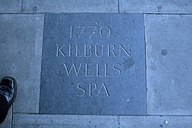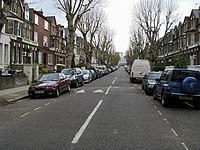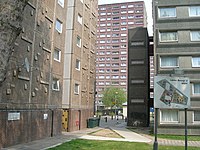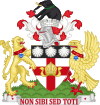Kilburn, London
| Kilburn | |
|---|---|
 Carlton Vale and The Shamrock public house | |
Location within Greater London | |
| Population | 29,027 (2011 Census Brent and Camden Wards)[1] [2] |
| OS grid reference | TQ245835 |
| London borough | |
| Ceremonial county | Greater London |
| Region | |
| Country | England |
| Sovereign state | United Kingdom |
| Post town | LONDON |
| Postcode district | NW6 |
| Dialling code | 020 |
| Police | Metropolitan |
| Fire | London |
| Ambulance | London |
| UK Parliament | |
| London Assembly | |
Kilburn is a locality on the boundary of three London Boroughs: Camden, Brent and the City of Westminster. Kilburn High Road railway station lies 3.5 miles (5.6 km) north-west of Charing Cross.
Kilburn developed from a linear hamlet that grew up on ancient Watling Street (the modern A5 Road), the hamlet took its name from Kilburn Priory, which was built on the banks of Kilburn Brook. Watling Street forms the contemporary boundary between the boroughs of Brent and Camden.
The area has London's highest Irish population, as well as a sizable Afro-Caribbean population, and was once home to the black civil rights leader Billy Strachan.[3]
Geographic and administrative context
[edit]Kilburn has never been an administrative unit and has therefore never had any formally defined boundaries. The area, which took its name from a nearby watercourse and eponymous priory, developed from a linear hamlet along Watling Street (here called Kilburn High Road) which was the boundary of the Ancient parishes of Willesden – to the west of Watling Street and now part of Brent, and Hampstead to the east (now part of Camden). These parishes subsequently became a Municipal and a Metropolitan Borough respectively (based on the same boundaries), before merging with neighbouring areas in 1965 to form modern London Boroughs of which they are now part.

If Kilburn is taken to extend into the City of Westminster then the historic districts it overlaps are Paddington, to the west of Watling Street, and Marylebone to the east of it. Both of these areas became part of the City of Westminster in 1965. The electoral wards of 'Kilburn (Camden)' and 'Kilburn (Brent)' cover some of the area. Much of the area is in the NW6 postcode area, and by some interpretations the area extends into W9; however these do not define the Kilburn – post code areas were never intended to delineate districts and Kilburn (like many London districts) overlaps with others – some which have a history of formal definition (e.g. Willesden, Hampstead) and others which do not (e.g. Brondesbury in Willesden).
History
[edit]Kilburn High Road originated as an ancient trackway, part of a route between the Brittonic settlements now known as Canterbury and St Albans. Under Roman rule, the route was paved. In Anglo-Saxon times the road became known as Watling Street.[4]
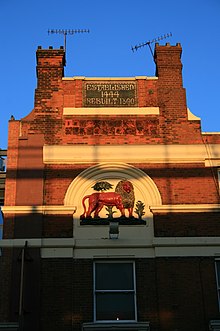
Kilburn Priory was built on the banks of a stream variously recorded as Cuneburna, Kelebourne and Cyebourne (in the latter source most other places with the phonetic sound /kiː/ were rendered in writing Cy such as Cynestone (Kingston)). The stream flowed from Hampstead through this parish then through Paddington – specifically through areas that became "Westbourne", "Bayswater" and Hyde Park – South Kensington and the narrow east part of Chelsea into the Thames. The first two names perhaps imply meanings of "King's Bourne" and "Cattle Bourne". The word Bourne is the southern variant of burn (any small "river"), as still commonly used in the technical term, winterbourne - a watercourse which tends to dry up in dry periods. The river is known today as the Westbourne. From the 1850s many of its feeder ditches were diverted into combined sewers feeding away to the east; it was otherwise piped underground and became one of London's underground rivers.[5]
The name "Kilburn" was first recorded in 1134 as Cuneburna, referring to the priory which had been built on the site of the cell of a hermit known as Godwyn.[6] Godwyn had built his hermitage by the Kilburn river during the reign (1100-1135) of Henry I, and both his hermitage and the priory took their name from the river.[7]
Kilburn Priory was a small community of nuns, probably Augustinian canonesses. It was founded in 1134 at the Kilburn river crossing on Watling Street (the modern-day junction of Kilburn High Road and Belsize Road). Kilburn Priory's position on Watling Street meant that it became a popular resting point for pilgrims heading for the shrines at St Albans and Willesden. Henry VIII's administration dissolved the priory in 1536–37, and nothing remains of it today[8] except the name of Abbey Road (in nearby St John's Wood), named from a track which once led to the priory.[9] The priory lands included a mansion and a hostium (a guesthouse), which may have been the origin of the Red Lion pub, thought to have been founded in 1444. Opposite, the Bell Inn opened around 1600, on the site of the old mansion.[7]
The fashion for taking "medicinal waters" in the 18th century came to Kilburn when a well of chalybeate waters (water impregnated with iron) was discovered near the Bell Inn in 1714. In an attempt to compete with the nearby Hampstead Well, gardens and a "great room" opened to promote the well, and its waters were promoted in journals of the day as cure for "stomach ailments":[7]
Kilburn Wells, near Paddington.—The waters are now in the utmost perfection; the gardens enlarged and greatly improved; the house and offices re-painted and beautified in the most elegant manner. The whole is now open for the reception of the public, the great room being particularly adapted to the use and amusement of the politest companies. Fit either for music, dancing, or entertainments. This happy spot is equally celebrated for its rural situation, extensive prospects, and the acknowledged efficacy of its waters; is most delightfully situated on the site of the once famous Abbey of Kilburn, on the Edgware Road, at an easy distance, being but a morning's walk, from the metropolis, two miles from Oxford Street; the footway from the Mary-bone across the fields still nearer. A plentiful larder is always provided, together with the best of wines and other liquors. Breakfasting and hot loaves. A printed account of the waters, as drawn up by an eminent physician, is given gratis at the Wells.
— The Public Advertiser, July 17, 1773[10]
In the 19th century the wells declined, but the Kilburn Wells remained popular as a tea garden. The Bell was demolished and rebuilt in 1863, the building which stands there today.[clarification needed] The Kilburn stretch of Watling Street, now called Edgware Road and Kilburn High Road, was gradually built up with inns and farm houses. Despite the discovery of the medicinal well in 1714, and the construction of gardens and a fine room to exploit the water, Kilburn did not attract any significant building until around 1819 in the area near St John's Wood.[7] These 19th century developments mark the emergence of the nucleated roadside hamlet from which the modern district of Kilburn developed.
Between 1839 and 1856 the newsagent and future First Lord of the Admiralty William Henry Smith lived in a house to the west of Kilburn High Road. Solomon Barnett developed much of the area in the last decades of the 19th century, naming many of the streets after places in the West Country (e.g. Torbay) or after popular poets of the day (e.g. Tennyson) in honour of his wife.[11]
The funeral of Michael Gaughan, an Irish republican and a member of the Provisional Irish Republican Army (IRA) who died from hunger strike in 1974, took place on 8 June 1974. Over 3,000 mourners lined the streets of Kilburn and marched behind his coffin - which was flanked by an IRA "honour guard" - to a Requiem Mass held in the Church of the Sacred Heart of Jesus.[12][13][14] The Biddy Mulligan's pub on High Road, which was popular among the local Irish population, was bombed in retaliation on 21 December 1975 by the Ulster Defence Association (UDA), an Ulster loyalist group during the Troubles of Northern Ireland. Although there were 90 people in the pub at the time of the bomb, there were few injuries. It was the only loyalist bombing to have occurred in London during the conflict in Northern Ireland.[15][16]
Demographics
[edit]Kilburn has a number of different ethnic groups, including people of Irish, Afro-Caribbean, Indian, Bangladeshi, Pakistani, Eritrean and Ethiopian descent. As the area is split between more than one London borough, statistics are gathered from different parts of Kilburn.[17][18]
The Kilburn ward of Brent was 28% White British, 17% White Other, and 12% Black African in the 2011 census.[19] The Kilburn ward of Camden was 35% White British and 19% White Other.[20] The Maida Vale ward of Westminster was 38% White British and 22% White Other.[21]
4.7% of the population was born in Ireland[22] with an even higher percentage of second-generation (born in England of Irish descent) people, [clarification needed] giving it the highest Irish population of any London area.[23] Irish community activities, pubs, local GAA sports clubs,[24] and annual St Patrick's Day celebrations are prominent in parts of the area. The 2007 Irish-language film Kings has been associated with Kilburn, a number of scenes were filmed there, and is based on Jimmy Murphy's play, The Kings of the Kilburn High Road.[25]
Housing and inequality
[edit]Kilburn has a high degree of socio-economic inequality, as it is home to both large and expensive Victorian houses as well as deprived, often run-down council housing estates.[citation needed]
Landmarks
[edit]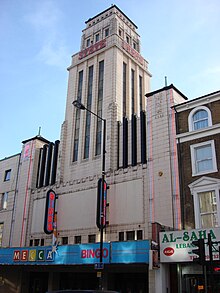


Kilburn High Road
[edit]Kilburn High Road is the main road in Kilburn. It follows a part of the line of the Roman route, Iter III in the Antonine Itinerary, which later took the Anglo-Saxon name Watling Street. This was based on an earlier Celtic route from Verlamion to Durovernum Cantiacorum, modern day St Albans and Canterbury.
Running roughly north-west to south-east, it forms the boundary between the London boroughs of Camden to the east and Brent to the west. It is the section of the Edgware Road (itself part of the A5) between Shoot Up Hill and Maida Vale.
There are two railway stations on Kilburn High Road: Brondesbury station (London Overground on the North London Line). Approximately 1.25 km (nearly a mile) further south is Kilburn High Road station (also London Overground, on the Watford DC Line). Kilburn Park Underground station, on the Bakerloo line, lies a little west of the southern end of the High Road. Kilburn Underground station sits on the northern side of the intersection of Christchurch Avenue and Kilburn High Road, which marks the High Road's northern boundary.
The green space of Kilburn Grange Park is located to the east side of Kilburn High Road.
The name of Ian Dury's first band, Kilburn and the High Roads, refers to this road, as does the Flogging Molly song, "Kilburn High Road" and the Shack song, "Kilburn High Road".
Gaumont State Cinema
[edit]A landmark in Kilburn High Road is the Grade II* listed Art Deco Gaumont State Cinema, designed by George Coles and opened in 1937. It was the biggest auditorium in Europe at the time, with seating for 4,004 people. For twenty years, the building was run as a bingo hall by Mecca Bingo. In December 2007, it was purchased by Ruach City Church.[26][27]
The Kiln Theatre
[edit]The Kiln Theatre is located on Kilburn High Road north of Buckley Road. It was opened in 1980 as the Tricycle Theatre in a converted Foresters' Hall, and was renamed the Kiln in April 2018.[28] The Kiln now includes a gallery and cinema as well as the theatre. It has a reputation for political dramas including dramatisations of significant court cases and a play about the US detention centre at Guantánamo Bay, Cuba, which subsequently transferred to the West End and to New York City. Reflecting the culturally diverse local community, the Kiln Theatre presents many international pieces and films, often in original language with English subtitles, and hosts or runs social and educational programmes.[29]
Other buildings
[edit]

To the south, the Kilburn skyline is dominated by the Gothic spire of St. Augustine's, Kilburn. Completed in 1880 by the architect John Loughborough Pearson, the church has an ornate Victorian interior, a carved stone reredos and screen and stained glass, adjacent to its partners, St Augustine's Primary and Secondary Schools. The church is sometimes nicknamed "the Cathedral of North London" due to its size[30] - at the time of construction, it was the third-largest place of worship in London, after St Paul's Cathedral and Westminster Abbey.
Located at 10 Cambridge Avenue, just off Kilburn High Road, is "The Animals WW1 memorial dispensary". The building itself dates back to the early 1930s. Formally opened in March 1931, it treated over 6,000 animals in its first year. The front of the building has a large bronze plaque above the door as a memorial to animals killed in the first world war. It's an impressive piece of bronze sculpture by F Brook Hitch of Hertford. Next door at 12-14 Cambridge Avenue, is one of the only surviving London examples of a "Tin Tabernacle" from 1863, which is currently used by a local arts charity. This very unusual building, originally built as St. James' Episcopal Chapel, is Grade II listed and is open to the public on Saturdays.[31]
Just to the south of St. Augustine's on Carlton Vale stands the rebuilt Carlton Tavern, a pub built in 1920-21 for Charrington Brewery and thought to be the work of the architect Frank J Potter. The building, noted for its unaltered 1920s interiors and faience tile exterior, was being considered by Historic England for Grade II listing when it was unexpectedly demolished in March 2015 by the property developer CLTX Ltd to make way for a new block of flats.[32] The pub was subsequently rebuilt and re-opened following a community campaign and planning appeals.[33]
205 High Road was home to the Irish pub Biddy Mulligan's. It was built in 1862 as was originally known as The Victoria Tavern. It was renamed in the 1970s, with the name Biddy Mulligan taken from a character of Irish comedian Jimmy O'Dea, a character dressed as a female street seller in Dublin from the 1930s onwards. The pub was bombed on 21 December 1975 by the Ulster Defence Association (UDA), an Ulster loyalist group that fought against Irish republicans in Northern Ireland (The Troubles). The pub was later renamed as Biddy's, before briefly turning into an Australian sports bar called Southern K, and then closing in 2009 to make way for a new Ladbrokes branch.[15][16]
Transport
[edit]
Tube/train
[edit]Kilburn High Road is served by several railway lines which traverse the road in an east–west direction, connecting the area with central London and outer north-west London suburbs. The railways were first introduced to Kilburn in 1852 when the London & North Western Railway opened Kilburn & Maida Vale station (today's Kilburn High Road railway station), followed by two stations opened in the Brondesbury area of Kilburn by the Hampstead Junction Railway (1860) and the Metropolitan Railway (1879). Numerous plans were drawn up at the turn of the 20th century to construct an underground railway tunnel under the length of the Edgware Road and Kilburn High Road, including an unusual scheme to build a type of subterranean monorail roller coaster, but these proposals were abandoned.[34] Today, Kilburn is served by London Underground and London Overground from the following stations:[35][36]
- Kilburn Park station (London Underground - Bakerloo line)- Central Kilburn
- Brondesbury station (London Overground - North London line)- North Kilburn
- Kilburn High Road station (London Overground - Watford DC line)- Central Kilburn
Despite its name, Kilburn tube station is actually in Brondesbury Park[37] rather than in Kilburn itself.
Bus
[edit]Kilburn is served by many bus routes that go along the High Road. Most routes come south from Cricklewood, and serve various points in central and west London.[38]
Media
[edit]The Brent & Kilburn Times and the Camden New Journal provide local news in print and online forms. In the 2017 film, The Only Living Boy in New York, Kate Beckinsale's character, Mimi, explains that she moved from Belsize Park to Kilburn because it felt more real.
Sport
[edit]Kilburn is home to Kilburn Cosmos RFC[39]
- South Kilburn F.C. play in the Combined Counties League
- Kilburn is home to Kilburn Gaels GAA Hurling Club.
- Kilburn Football Club play in the Middlesex County League, and hold regular training sessions in Grange Park.
- One of the 12 founder members of the Football Association was formed in Kilburn in 1863. It was referred to as the N.N. Club or N.N. Kilburn, "N.N." being thought to stand for "Non Name". It supplied the first president of the Football Association.
London Plan
[edit]The area is identified in the London Plan as one of 35 major centres in Greater London.[40]
Notable residents
[edit]Notable people who live or have lived in Kilburn include:
- Oni Akerele
- Lily Allen, singer
- Gerry Anderson
- Roderick Bradley
- Todd Carty
- Edwyn Collins
- Jack Dromey[41]
- Brian Eno
- Zuhair Hassan, rapper
- Thomas Hodge
- Thandiwe Newton
- Jason Isaacs
- Annie Mac
- Doreen Massey
- A. A. Milne
- George Orwell
- China Miéville[42]
- David Mitchell, comedian
- Kate Moss
- Cillian Murphy
- Richard Pacquette, footballer
- Daisy Ridley
- Gavin Rossdale
- Andrew Sachs, actor[43]
- Zadie Smith
- Tommy Sparks
- Josiah Stamp, 1st Baron Stamp
- Billy Strachan, Civil rights leader
- Charles "Chucky" Venn
- Louis Wain[44]
- Jamie Waylett, actor
- Robert Webb, actor
- David Winner, author
- Bradley Wiggins, cyclist
- Fredo, rapper
References
[edit]- ^ "Brent Ward population 2011". Neighbourhood Statistics. Office for National Statistics. Archived from the original on 21 October 2016. Retrieved 19 October 2016.
- ^ "Camden Ward population 2011". Neighbourhood Statistics. Office for National Statistics. Archived from the original on 21 October 2016. Retrieved 20 October 2016.
- ^ Horsley, David (2019). Billy Strachan 1921-1988 RAF Officer, Communist, Civil Rights Pioneer, Legal Administrator, Internationalist and Above All Caribbean Man. London: Caribbean Labour Solidarity. p. 14. ISSN 2055-7035.
- ^ "The Virtual Tour of Kilburn". Archived from the original on 21 March 2007. Retrieved 7 December 2014.
- ^ See London sewerage system
- ^ Edward Wedlake Brayley (1834). The Graphic and Historical Illustrator: An Original Miscellany of Literary, Antiquarian and Topographical Information (JPG, PDF). J. Chidley. p. 336. Retrieved 7 December 2014.
cuneburna.
- ^ a b c d T.F.T. Baker; Diane K. Bolton; Patricia E.C. Croot (1989). C.R. Elrington (ed.). "Kilburn, Edgware Road and Cricklewood". A History of the County of Middlesex: Volume 9 (sourced from British History Online). Retrieved 7 December 2014.
- ^ "Kilburn". Brent Heritage. 2002. Archived from the original on 18 July 2014. Retrieved 7 December 2014.
- ^
Mills, A. D. (2001). A Dictionary of London Place-Names (2 ed.). Oxford: Oxford University Press (published 2010). p. 1. ISBN 9780199566785. Retrieved 16 June 2016.
Abbey Road (in St John's Wood) [...]. Developed in the early 19th century from an earlier track, and so named from the medieval priory at Kilburn to which it led. Chiefly famous of course as the name of the 1969 Beatles album recorded here at the EMI studios!
- ^ "Kilburn and St John's Wood". British History Online. Retrieved 7 December 2014.
- ^ "Queens Park". Camerons Stiff & Co. Retrieved 14 November 2024.
- ^ Aengus O Snodaigh. "Take me home to Mayo – 25th anniversary of Michael Gaughan's death". An Phoblacht. Retrieved 13 June 2007.
- ^ "work of Raymond Jackson". British Cartoon Archive. Archived from the original on 24 October 2007. Retrieved 13 June 2007.
- ^ "Kilburn Funeral". British Cartoon Archive. Retrieved 13 June 2007.
- ^ a b "An IRA funeral march and the bomb at Biddy Mulligan's Pub". Kilburnandwillesdenhistory.blogspot.co.uk. 8 August 2015. Retrieved 6 January 2018.
- ^ a b [1] [permanent dead link]
- ^ Brent Council (2001). "Kilburn Ward 2001 census". Archived from the original on 8 February 2009. Retrieved 7 December 2014.
- ^ Camden Council (2001). "Kilburn Ward 2001 census". Archived from the original on 9 February 2009. Retrieved 7 December 2014.
- ^ Services, Good Stuff IT. "Kilburn - UK Census Data 2011". UK Census Data. Retrieved 6 January 2018.
- ^ Services, Good Stuff IT. "Kilburn - UK Census Data 2011". UK Census Data. Retrieved 6 January 2018.
- ^ Services, Good Stuff IT. "Maida Vale - UK Census Data 2011". UK Census Data. Retrieved 6 January 2018.
- ^ UK Office for National Statistics. "Kilburn Population". City Population. Retrieved 16 June 2019.
- ^ "In the Green Fields of Kilburn: Reflections on a Quantitative Study of Irish Migrants in North London" (PDF). Anthropology Matters Journal. February 2002. Archived from the original (PDF) on 19 February 2012. Retrieved 7 December 2014.
- ^ "Kilburn Gaels Hurling Club". Retrieved 7 December 2014.
- ^ Ferriter, Diarmuid. "Paddies' pain". Irish Examiner. Archived from the original on 8 February 2009. Retrieved 7 December 2014.
- ^ "About". www.ruachcitychurch.org. Retrieved 6 June 2022.
- ^ Leadbeater, Chris (30 January 2019). "Glorious ghosts of yesteryear – in search of London's 'lost' Art Deco cinemas". The Telegraph. ISSN 0307-1235. Retrieved 6 June 2022.
- ^ Iqbal, Nosheen (11 April 2018). "Kilburn's Tricycle relaunches as Kiln theatre with Zadie Smith's White Teeth". The Guardian. Retrieved 11 April 2018.
- ^ "Our Impact". Kiln Theatre. 2018. Archived from the original on 6 July 2018. Retrieved 5 July 2018.
- ^ "Saint Augustine's Kilburn". staugustinekilburn.org. Archived from the original on 24 September 2020. Retrieved 9 September 2020.
- ^ "Tin Tabernacle Kilburn". Tin Tabernacle. Archived from the original on 29 August 2018. Retrieved 5 July 2018.
- ^ "Bulldozers level historic pub after being denied planning permission". The Telegraph. Archived from the original on 16 April 2015. Retrieved 17 April 2015.
- ^ "Rising from the rubble: London pub rebuilt brick by brick after illegal bulldozing". the Guardian. 21 March 2021. Retrieved 29 November 2022.
- ^ Badsey-Ellis, Antony (2005). London's lost tube schemes. Harrow: Capital Transport. pp. 62–63, 79–83, 264–267. ISBN 1-85414-293-3.
- ^ "Kilburn station". TfL. Retrieved 14 January 2014.
- ^ "Kilburn High Road". National Rail. Retrieved 14 January 2014.
- ^ Services, Good Stuff IT. "Brondesbury Park - UK Census Data 2011". UK Census Data. Retrieved 6 January 2018.
- ^ Transport for London (2012). "Buses from Kilburn High Road" (PDF). Bus route map. Retrieved 14 January 2014.
- ^ "Kilburn Cosmos RFC". Kilburn Cosmos RFC. Retrieved 5 June 2020.
- ^ Mayor of London (February 2008). "London Plan (Consolidated with Alterations since 2004)" (PDF). Greater London Authority. Archived from the original (PDF) on 2 June 2010.
- ^ "Jack Dromey for Erdington". Archived from the original on 11 July 2015. Retrieved 9 July 2015.
- ^ "3am Interview: THE ROAD TO PERDIDO: AN INTERVIEW WITH CHINA MIEVILLE". 3ammagazine.com. Retrieved 6 January 2018.
- ^ Osley, Richard (30 October 2008). "Make a meal of it! Fawlty Towers actor in BBC Radio 2 row opens brand new hospital restaurant". Camden New Journal. New Journal Enterprises. Retrieved 14 December 2008.
- ^ "A celebration of Louis Wain's Cats at Brent Museum". Blog.wellcomelibrary.org. Retrieved 6 January 2018.
External links
[edit]- Tourist information Archived 16 July 2012 at the Wayback Machine
- History of Kilburn's Theatres



